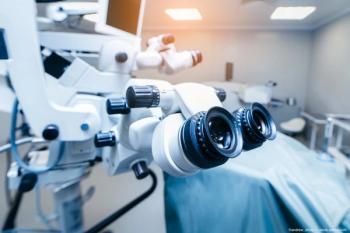
Metabolome-wide study finds link between androgen metabolism and dry eye
A metabolomics study found a link between dry eye disease and androgen metabolism in females.
Take home:
A metabolomics study found a link between dry eye disease and androgen metabolism in females.
By Vanessa Caceres; Reviewed by Jelle Vehof, MD
Androgen metabolism may be an important pathway related to dry eye disease in females.
Researchers-led by Jelle Vehof, MD, of Twin Research & Genetic Epidemiology at St. Thomas’ Hospital, King’s College London, and the Department of Ophthalmology, University Medical Center Groningen, Groningen, Netherlands-studied metabolomics to pinpoint their findings in a metabolome-wide study of dry eye disease.
“Metabolomics is a new emerging field of ‘-omics’ research,” Dr. Vehof said. “Next to the genome, the transcriptome, and the proteome, there is the metabolome. A person’s metabolome refers to a snapshot of all the small molecule metabolites in a biological cell or tissue.”
Because metabolomes are dynamic and change from second to second, they can help researchers study disease pathogenesis or to scan diagnostic biomarkers, Dr. Vehof said.
Dr. Vehof and colleagues believed metabolomics would be valuable to study dry eye because they are a measurable direct product of genes and environmental factors.
“The aim of the study was to explore the relationship between dry eye disease and serum metabolites, given the known associations of dry eye with several metabolic dysfunctions,” according to the study abstract.
Researchers studied 1,622 population-representative female volunteers from the Twins UK Adult Twin Registry, which has been used to study the genetic basis of various cardiovascular, metabolic, musculoskeletal, and ophthalmic disorders.
Dr. Vehof and colleagues performed a non-targeted metabolomics analysis of plasma samples with the use of gas- and liquid-chromatography along with mass spectrometry. This enabled them to measure 390 metabolites in plasma samples.
A dry eye diagnosis was determined with the Short Questionnaire for Dry Eye Syndrome (SQ-DES), administered in 2011 and 2013. The incidence of a dry eye diagnosis was also used as an outcome variable.
The dry eye findings
Researchers found a dry eye prevalence of 16.7% with the SQ-DES.
“A strong and metabolome-wide significant association with dry eye diagnosis was found with the metabolite epiandrosterone,” the study abstract reported. “Epiandrosterone and two other steroids that are also involved in androgen metabolism were particularly strongly associated with dryness symptoms on the SQ-DES.”
The researchers also found an association between epiandrosterone and the incidence of dry eye diagnosis. Dehydroepiandosterone sulfate (DHEAS) seemed also associated with a dry eye diagnosis, but it did not reach metabolome-wide significance.
The study suggests that androgen metabolism may be an important pathway in the development of dry eye disease in women, Dr. Vehof and colleagues concluded. Specifically, epiandrosterone may be a biomarker of dry eye because of its association with both the prevalence and incidence of disease.
Previous animal and patient studies have shown that androgens have a role in lacrimal and meibomian gland dysfunction, the study abstract reported. However, the related studies have been small, Dr. Vehof said.
A metabolomics study of dry eye allows researchers to track the condition’s association with possible systemic pathophysiologic processes, Dr. Vehof said. The fact that women have a higher prevalence of dry eye and the association of dry eye with various systemic diseases and medications, point to systemic involvement in dry eye’s pathophysiology and justified the study, according to researchers.
“The strong association with all androgen metabolites in this large population-representative hypothesis-free study was actually quite surprising for us, pointing out that androgens are important in this disease, and implicating that further studies on this topic are justified,” Dr. Vehof said.
Dr. Vehof would like to see further randomized, controlled trials that focus on androgen treatment and other studies investigating the role of androgens in dry eye.
The researchers in this study are planning a genome-wide association study on dry eye disease.
“Of course, we will have a close look at the androgen genes,” Dr. Vehof said.
Jelle Vehof, MD
This article was adapted from Dr. Vehof’s presentation at the 2014 meeting of the Association for Research and Vision in Ophthalmology. Dr. Vehof did not indicate any proprietary interest in the subject matter.
Newsletter
Don’t miss out—get Ophthalmology Times updates on the latest clinical advancements and expert interviews, straight to your inbox.


















































.png)


